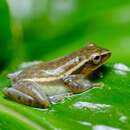en
names in breadcrumbs


The striped Asian treefrog, Feihyla vittata, inhabits grassy savannahs and open areas in subtropical and tropical forests across South East Asia from India, into China, to Thailand and Vietnam. It breeds in still water: swamps, ponds, rain pools, and paddy fields.As it can tolerate to a human-induced habitat modifications and live in degraded forests and irrigated lands, it is common across its range and not considered to be a threatened species (Lau et al. 2004).
Recent molecular phylogenetic analyses confirm this frog in genus Feihyla rather than the previously accepted Chiromantis (as Chiromantis vittatus; Yu et al. 2008; Li et al 2009; Li et al. 2013).However, F. vittata is genetically quite distinct from, and in multiple analyses is not in a monophyletic group with, with the Feihyla type species (F. palpebralis).Meegaskumbura et al. (2015) suggest F. vittata may in fact require its own genus. In molecular, morphological and bioacoustic analysis of call behavior of Chiromantis frogs, Aowphol et al. (2013) show that F. vittatus contains more diversity than previously understood.Their research supports a second, distinct and geographically isolated lineage of F. vittata in northern Myanmar and western Thailand.
Striped Asian treefrogs are gel-nesters.They lay their eggs in a viscous gel above water.The tadpoles hatch partly developed, and drop into the water to complete their development.This developmental strategy is distinguished from Chiromantis species (and other rhacophorid frog species) in which tadpoles develop in a foam nest deposited above the water (Meegaskumbura et al. 2015).
Rohanixalus vittatus is a species of frog in the family Rhacophoridae. It is found in Northeast India, Bangladesh, Myanmar, Thailand, Cambodia, Laos, and Vietnam, as well as in isolated populations in southern China (in southeastern Tibet, southern Yunnan and Guangxi, Hainan, Guangdong, and Zhejiang). Many common names have been coined for it: two-striped pigmy tree frog, Bhamo tree frog, Boulenger's tree frog, striped Asian treefrog, violet pigmy tree frog, and lateral-striped opposite-fingered treefrog.[2][3]
Formerly described in Feihyla, it was moved to the new genus Rohanixalus in 2020 following a phylogenetic study.[3]
Rohanixalus vittatus occurs in open grassy areas in forest and forest edge at elevations up to about 1,500 m (4,900 ft). It tolerates some habitat modification and also occurs in rice paddies. It is a widespread and generally common species that is not facing known threats. Its range includes a number of protected areas.[1]
Rohanixalus vittatus is a species of frog in the family Rhacophoridae. It is found in Northeast India, Bangladesh, Myanmar, Thailand, Cambodia, Laos, and Vietnam, as well as in isolated populations in southern China (in southeastern Tibet, southern Yunnan and Guangxi, Hainan, Guangdong, and Zhejiang). Many common names have been coined for it: two-striped pigmy tree frog, Bhamo tree frog, Boulenger's tree frog, striped Asian treefrog, violet pigmy tree frog, and lateral-striped opposite-fingered treefrog.
Formerly described in Feihyla, it was moved to the new genus Rohanixalus in 2020 following a phylogenetic study.
Rohanixalus vittatus occurs in open grassy areas in forest and forest edge at elevations up to about 1,500 m (4,900 ft). It tolerates some habitat modification and also occurs in rice paddies. It is a widespread and generally common species that is not facing known threats. Its range includes a number of protected areas.